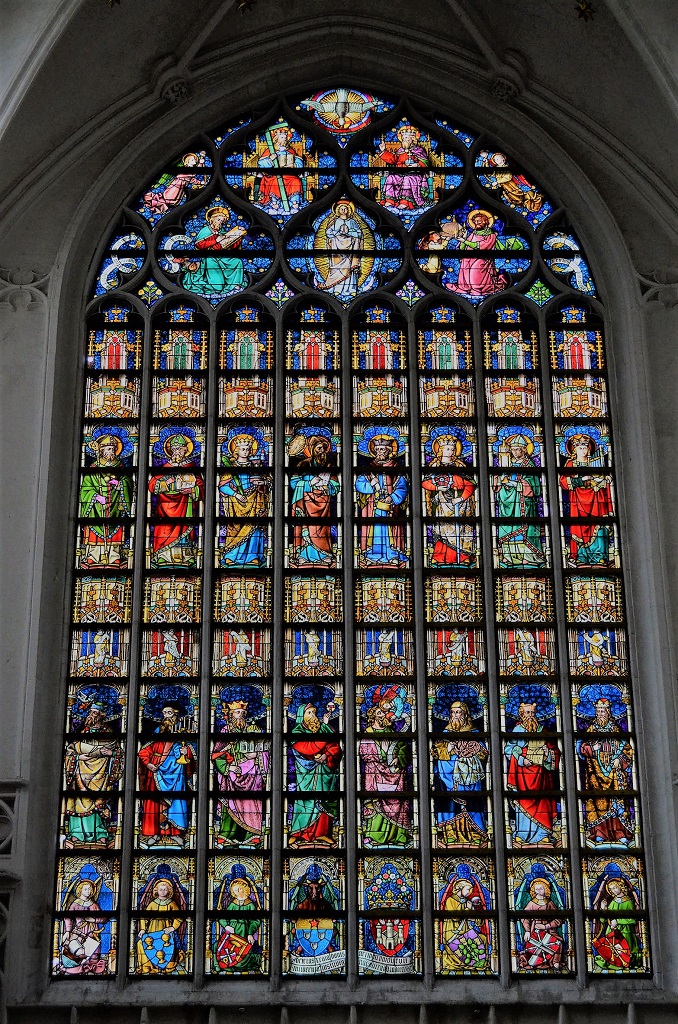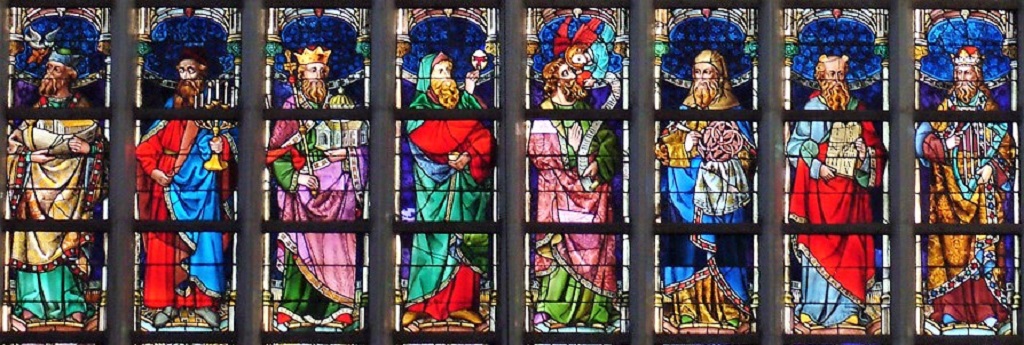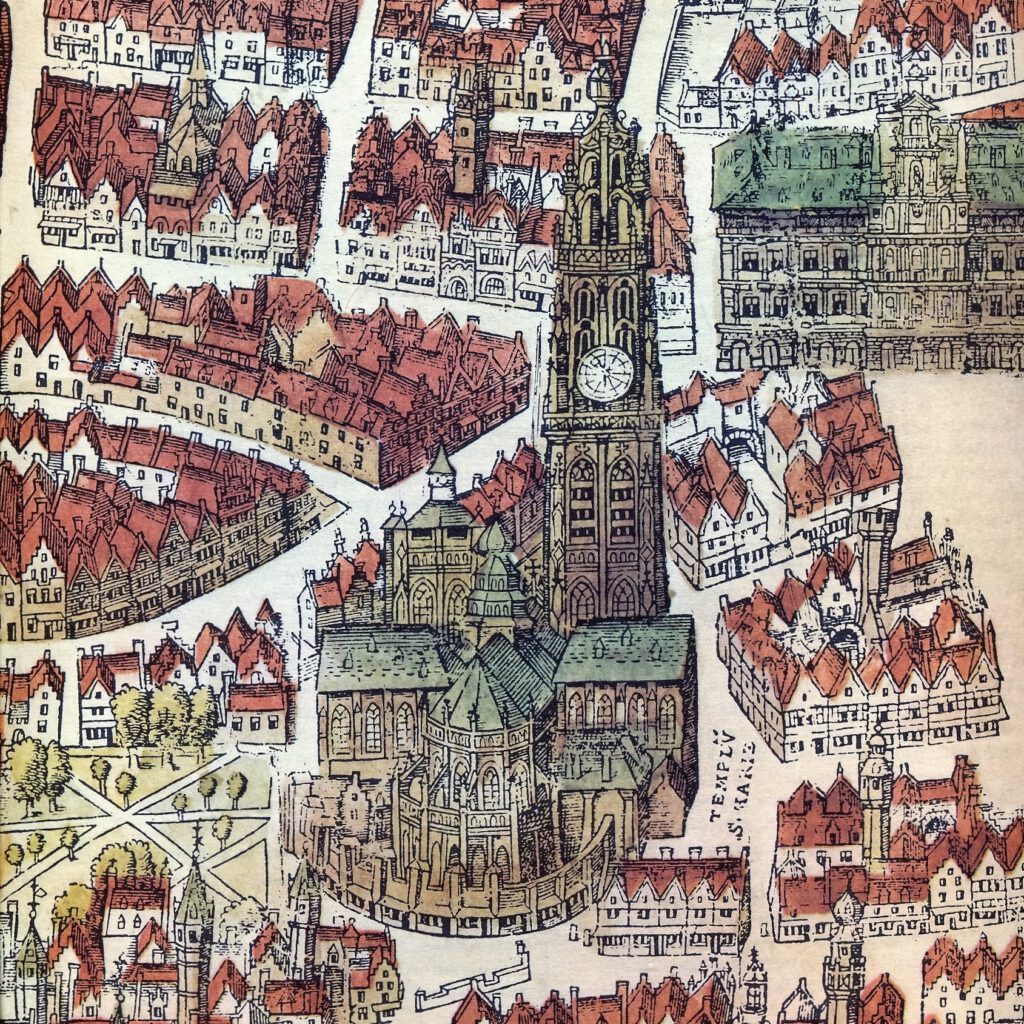The Our Lady’s Cathedral of Antwerp, a revelation.
God glorified by the arts,
stained glass window southern transept Jean-Baptiste Bethune, 1872
After the Baroque window of king Philip III of Spain had been severely damaged by storm, it was ‘made white’ in 1802, i.e. replaced by transparent glass. Sixty years later this void permitted ‘The Royal Society to Promote the Fine Arts in Antwerp’ to commission the famous neo-Gothic stained-glass artist Jean-Baptiste Bethune to make a grand stained glass window. The second centennial of the Royal Academy of Fine Arts (1863) and the fourth centennial of SaintThis is a title that the Church bestows on a deceased person who has lived a particularly righteous and faithful life. In the Roman Catholic and Orthodox Church, saints may be venerated (not worshipped). Several saints are also martyrs. Luke’s Guild (1854) were the double occasion for this. Not only the arts that are practised at the Academy have been pictured to honour God, also the disciplines of the chambers of rhetoric, poetry and eloquence, church music – which is so important for liturgy – philosophy and theology, while economics, which makes all this possible and which in Antwerp is mainly maritime trade, is given first position.
In each of the eight (vertical) columns one of these disciplines is pictured, each time by means of four representations in as many (horizontal) rows. From bottom to top: the escutcheon of those who practise this discipline in Antwerp, an old testamentPart of the Bible with texts from before the birth of Jesus. figure who practised the discipline, a little man with the Latin name of the discipline concerned on a banderol and on top the patron saint of this discipline, preferably someone who practised it him- or herself.
From left to right:
[1] The shipping company · navicularia Noah is carrying a scale model of his ark, accompanied by a flying dove with a palm. Saint Nicholas’s attribute are the three round gold nuggets that he offered to poor girls as a dowry so as to keep them out of prostitution. Or profit for the benefit of charity, and so of God.
[2] The gold & silversmiths’ art · metalorum fabrica The coat of arms of the Antwerp gold & silversmiths shows three ciboriums. Because he was so skilful in working wood, precious stones and metals Besalel was asked by Moses to make the Ark of the Covenant and the seven branched candleholder of the Temple of Jerusalem (Exod. 31:1-11). The goldsmith Saint Eligius is holding a small hammer and a reliquaryContainer for relics. Often this is a philatory: a decorated glass holder on a pedestal, in which a relic can be placed for veneration. It is important to know that relics cannot be worshipped, only venerated..
[3] Architecture · architectura As he had the Temple built, King Solomon is carrying a scale model of it. Saint Barbara, with her princess’s crown, and carrying a palm to indicate she is a martyrSomeone who refused to renounce his/her faith and was therefore killed. Many martyrs are also saints., has become the patron of builders of towers and fortifications, because she was locked up in a tower.
[4] Painting · pictura has been represented by the coat of arms of ‘The Royal Society to Promote the Fine Arts in Antwerp’, whose Latin name occurs as the commissioner of this stained-glass window. It is held by a winged ox, the symbol of Luke the evangelist. According to the vision of Ezekiel (9:3-4) an Israelite, a ‘man clothed in linen at whose loins was the writing case’ put up a sign so that people could be saved. The church fathers identified this sign as a ‘T’ (tau), a prefiguration of Jesus’s cross. Its red colour refers to the lamb’s blood that the Jews applied (non figuratively!) at the doorposts of their houses just before their exodus from Egypt (Exod. 12:7.13). The blessedUsed of a person who has been beatified. Beatification precedes canonisation and means likewise that the Church recognises that this deceased person has lived a particularly righteous and faithful life. Like a saint, he/she may be venerated (not worshipped). Some beatified people are never canonised, usually because they have only a local significance. Jacobus Griesinger from Ulm (1407-1491) used to be a stained-glass artist before he entered the Dominican Order to be a friar. He is drawing a Calvary, inspired by the crucified Jesus: sign of salvation of entire humanity.
[5] Eloquence · eloquentia is one of the disciplines of the chambers of rhetoric, of which the oldest one became part of Saint Luke’s guild in 1480. The coat of arms is this of the city of Antwerp, whose administration consisted of jurists. The lips of the prophet Isaiah are purified with an ember by a seraph (Is. 6:6). Saint Ivo, lawyer and canonist, who is wearing a gown and cap, takes a scroll with a seal from his briefcase, which has a lock.
[6] Poetry and philosophy · poesis et philosoph(ia) with the coat of arms of the chamber of rhetoric ‘De Goudbloem’ (The Marigold). The prophet Ezekiel, who received the order from God to speak to people and to note these words in his book, is holding a book in his hands on which there are four winged wheels, because he saw God descend on four winged creatures on four entwined cart wheels (Ez. 1:15-21). According to tradition the king’s daughter Saint Catherine of Alexandria would have converted to Christianity the philosophers who had to dissuade her from Christianity. Because the first attempt to kill her on a wheel failed, she was beheaded with a sword. Hence her attributes.
[7] Theology · theologia Above the escutcheon of the Antwerp Saint Michael’s AbbeyA set of buildings used by monks or nuns. Only Cistercians, Benedictines, Norbertines and Trappists have abbeys. An abbey strives to be self-sufficient., founded by Saint Norbert, is Moses with the stone tablets of the law, i.e. the Ten Commandments, with on the left the numbers I to III for the Godly commandments, and on the right the numbers IV to X for the commandments that regulate relationships among humans. The tower monstranceA decorated glass holder on a base, in which a consecrated host can be placed for worship. In general, there are two types of monstrances: the ray monstrance and the tower monstrance, with the name referring to the shape of the object. The tower monstrance is very similar to the reliquary, which was very popular before the adoration of the Blessed Sacrament became widespread. that Norbert is holding alludes to his actions against the heresy of Tanchelm in Antwerp.
[8] Music · musica Above the coat of arms of the city musicians Kind David accompanies the singing of psalms with a harp. Saint Cecilia, the patron saint of church music, is carrying the modello of a positive organ.
In the tracery: Holy TrinityThe concept that there is one God who shows himself in threefold form: Father, Son (Jesus of Nazareth) and the Holy Spirit.. God the FatherPriest who is a member of a religious order. enthroned, dressed in imperial purple, blesses mankind. Christ is dressed in red (of love that is prepared to sacrifice one’s own blood) and wrapped in a green cloak (sign of hope and new life). The green wooden cross in the shape of a T stands for faith and Jesus’s sacrifice of love. In his hands the book of life is open on the pages with ‘A and O’. The white dove is the allegory of the Holy SpiritThe active power of God in people. It inspires people to make God present in the world. Jesus was ‘filled with the Holy Spirit’ and thus showed in his speech and actions what God is like. People who allow the Holy Spirit to work in them also speak and act like God and Jesus at those moments. See also ‘Pentecost’.. Two angels praise God by swaying censers to Him. White and blue, the colours of Mary’s Immaculate Conception, have been her typical colours since the apparitions in Lourdes in 1854. Saint Luke, the patron saint of the arts and especially of painting, is given the honour of sitting iconographically right of Jesus. He ‘described’ Mary and Child with a brush – according to the legend he painted them from nature – but the infant Jesus does not occur on the stained glass window. On the banderol, in the mouth of the ox, his attribute, is a paraphrase of the first verse of Saint Luke’s gospelOne of the four books of the Bible that focus on Jesus’s actions and sayings, his death and resurrection. The four evangelists are Matthew, Mark, Luke, and John. ‘Gospel’ is the Old English translation of the Greek evangeleon, which literally means ‘Good News’. This term refers to the core message of these books. (1:1): ‘Quid nam multi conatus’ (what many have attempted). Of course this refers to the (apocryphal) story of him painting the portrait of Mary and Child. The apostleThis is the name given to the principal twelve disciples of Jesus, who were sent by Him to preach the gospel. By extension, the term is also used for other preachers, such as the Apostle Paul and Father Damien (“The Apostle of the Lepers”). Saint Thomas, who was killed by Hindu fanatics when he was building a church on his mission in Southern India, has therefore become the patron saint of architects. Here his attribute is the scale model of an Eastern church.
At the bottom of the tracery are the emblems of the most important chambers of rhetoric. On the left we can see De Goudbloem (The Marigold), in the middle twice De Violieren (The Violets) and on the right De Olijftak (The Olive Branch). Left and right in the tracery are banderols with rhymed invocations of patron saints.

In 1836 a railroad connected Antwerp with Malines and Brussels. In the same year, so as to get a more regulated measuring of time for the expanding railroad traffic, the government of young Belgium gave the order to Adolphe Quetelet, the head of the then Brussels Observatory (now in Ukkel) to measure time in the cities more accurately, on the base of the normal local solar time. For this purpose some forty giant meridian lines were installed. In 1838 one of these appeared in the transeptThe transept forms, as it were, the crossbeam of the cruciform floor plan. The transept consists of two semi transepts, each of which protrudes from the nave on the left and right. of this main church, in the shape of a brass line. The light openings in the neo-Gothic stained glass window have been preserved, top and bottom left. In winter the patch of light falls perfectly on the brass strip in the northern transept since at noon on 21 December the sun is at its lowest. In the summer this happens in the southern transept, because on 21 June it is at its highest. From 1993 the patch of light was not clearly visible anymore in the crossingThe central point of a church with a cruciform floor plan. The crossing is the intersection between the longitudinal axis [the choir and the nave] and the transverse axis [the transept]. because there a new marble altarThe altar is the central piece of furniture used in the Eucharist. Originally, an altar used to be a sacrificial table. This fits in with the theological view that Jesus sacrificed himself, through his death on the cross, to redeem mankind, as symbolically depicted in the painting “The Adoration of the Lamb” by the Van Eyck brothers. In modern times the altar is often described as “the table of the Lord”. Here the altar refers to the table at which Jesus and his disciples were seated at the institution of the Eucharist during the Last Supper. Just as Jesus and his disciples did then, the priest and the faithful gather around this table with bread and wine. stage had been built, on top of the brass strip. This is why a third opening has been made so that the sun enters the cathedralThe main church of a diocese, where the bishop’s seat is. in a different angle and so that the patch of light can fall further on the brass strip in the northern transept.
- Our Lady’s Cathedral
- History & Description
- Preface
- Introduction
- Historical context
- A centuries-long building history
- A cathedral never stands alone
- Our Lady’s spire
- The main portal
- Spatial effect
- Mary’s Assumption (C.Schut)
- Erection of the Cross (PP.Rubens)
- Descent of the Cross (PP.Rubens)
- The Resurrection (PP.Rubens)
- Mary’s Assumption (PP.Rubens)
- The high altar
- The collegial choir
- The bishop’s church
- The parish church
- The pulpit
- The confessionals
- Caring for the poor
- The Venerable chapel
- Mary’s chapel
- Corporations and guilds
- The ambulatory
- Funeral monuments
- Praise the Lord!
- Pull all stops: the organs
- Cross-bearer (J.Fabre)
- Bibliography






